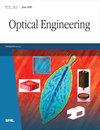Spatial aliasing quantification and analysis of existing imaging sensors: NASA’s Hubble Space Telescope, OrbView-3 OHRIS, and commercial-off-the-shelf camera for autonomous robots
IF 1.2
4区 工程技术
Q4 OPTICS
引用次数: 0
Abstract
Abstract. Spatial aliasing in its most pronounced form is seen as a Moiré pattern in (sampled) images. Less dramatically, aliasing is a form of image quality (IQ) degradation and exists at some level within any (sampled) image. More sampling tends to improve IQ due to less aliasing; however, there are drawbacks. Spatial aliasing has been recently quantified by Mudge [Appl. Opt.62(13), 3260–3264 (2023)] for imaging sensors (optics plus detector). This quantification allows a trade to be made between the acceptable aliasing errors imbedded within the (sampled) image and the penalty, or cost, associated with additional sampling, e.g., increased complexity, data throughput and storage, and reduced signal-to-noise ratio for fixed arrays or increased scan time. In this work, we examine several existing and useful imaging sensors along with their imagery and aliasing errors to appreciate how well these existing systems are designed with respect to sampling to better inform how future systems could potentially be improved. Finally, from these analyses, a 2% aliasing error rule is extracted initiating a universal aliasing boundary.现有成像传感器的空间混叠量化和分析:美国国家航空航天局哈勃太空望远镜、OrbView-3 OHRIS 和用于自主机器人的商用现成相机
摘要空间混叠最明显的表现形式是(采样)图像中的摩尔纹。不那么明显的混叠是图像质量(IQ)下降的一种形式,在任何(采样)图像中都存在一定程度的混叠。采样越多,混叠越少,IQ 也就越高。Mudge [Appl. Opt.62(13), 3260-3264 (2023)]最近对成像传感器(光学器件加探测器)的空间混叠进行了量化。这种量化方法可以在(采样)图像中可接受的混叠误差与额外采样带来的损失或成本(如复杂性、数据吞吐量和存储量的增加,以及固定阵列信噪比的降低或扫描时间的增加)之间进行权衡。在这项工作中,我们对现有的几种有用的成像传感器及其图像和混叠误差进行了研究,以了解这些现有系统在采样方面的设计如何,从而更好地为未来系统的潜在改进提供信息。最后,我们从这些分析中提取出 2% 的混叠误差规则,并以此作为通用的混叠边界。
本文章由计算机程序翻译,如有差异,请以英文原文为准。
求助全文
约1分钟内获得全文
求助全文
来源期刊

Optical Engineering
工程技术-光学
CiteScore
2.70
自引率
7.70%
发文量
393
审稿时长
2.6 months
期刊介绍:
Optical Engineering publishes peer-reviewed papers reporting on research and development in optical science and engineering and the practical applications of known optical science, engineering, and technology.
 求助内容:
求助内容: 应助结果提醒方式:
应助结果提醒方式:


